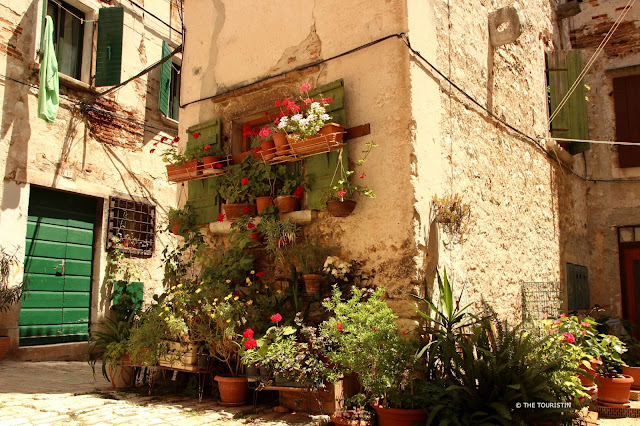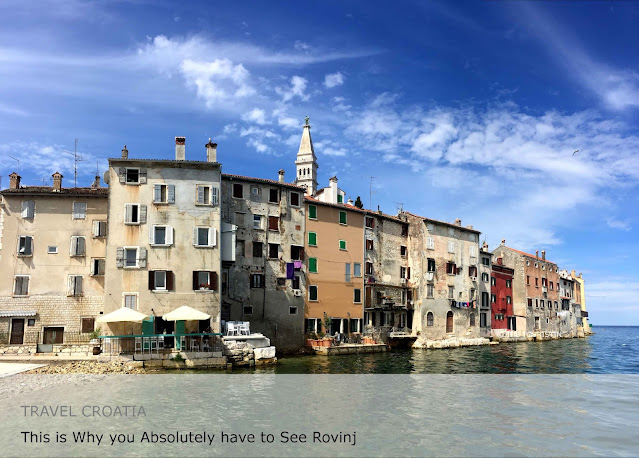From Berlin, I drive 1,200 km through Germany, Austria,
and Slovenia, and I also come very close to Italy before I reach Rovinj in Istria on
the Adriatic Coast in Croatia. It is fantastic how diverse all these countries
are, and as a very happy citizen of a globalized world, I appreciate every
single one. Croatia is really one of the prettiest places to visit. Excellent
food, clear waters, and what I really love is that people have the best humour;
it is just such a great place. If you haven’t been yet, go and make a plan.
Now.
 |
| Cobblestoned lane in the car free old town of Rovinj |
Rovinj is one of the most enchanting places. I love to
look at the history of the place I visit. The first thing I always have to find
out is how old a place is. And Rovinj surely went to the most exciting times in
its lifetime. What follows is what happened so far, in a few sentences.
The Romans occupied Istria till 476, after that the Huns
and the Byzantine came. It later fell under Frankish rule. Between the 9th and the 11th century towns were looking for autonomy and urban structures were established. Venice, a maritime republic, took over the island of Rovinj in 1283
and started a ship building tradition. Rovinj grew, the channel between the
island and the mainland was closed, and the island ended up being a peninsula.
The church St. Euphemia was built, and in 1797 Venice lost its power to
Austria. When Napoleon took charge everything changed again, but he could only
hold onto it for a mere few years before Austria was back in the saddle to turn
Rovinj into an industrial hub with a flourishing industry, with a theatre and a
hospital for its citizens. The town had a railway line, was connected to the
telephone line, and gas lamps were installed.
The Habsburg monarchy fell apart, and at the end of WW1
fascist Italy took over until the town fell under German occupation in 1943.
After WW2 Rovinj became part of Yugoslavia. A war was fought from 1991 to 1995.
The days of the Yugoslav wars were troublesome and filled with horrific events;
eventually the country became independent in 1992. Croatia joined the EU as a
member in the summer of 2013.
 |
| Old town Rovinj |
How
far is Croatia from Italy and Rovinj from Venice?
Venice is so close to Rovinj, one could walk really, just
assuming you are a sporty person and split the 245 kilometres to turn it into a
little walking adventure. If you prefer to go by car it is a quick three hours’
drive. You would even come across Trieste in Italy, which is the town where poet
Rainer Maria Rilke started to write the Duino Elegies. You see, it is all very
nearby, and it is no surprise at all to hear that “Croatian as well as Italian
is officially spoken in this part of the world” from the stall holder at the
farmers market I buy my truffle oil from. In Italian the town is called Rovigno.
 |
| The streets of Rovinj |
I couldn’t wait to see what Rovinj is like. The splendour
of Rovinj with its pastel coloured houses in the old town is delightful. There
are cobbled lanes all over town; with baroque- and Venetian style architecture.
It actually feels like you are walking through the centuries, almost as if time
stood still. There are the well-trodden paths of visitors, but as so very
often, you only have to stray a few metres further and you seemingly have the
town all by yourself. Hang on, that is not entirely true. On a tiny square,
framed by colourful houses I hear a snoring sound, and look around me to find
the source of it. There is a black and white cat, lying in the full sunshine,
on a bench, sleeping. The constant sound echoes through the air, softly banging
on the flower clad facades with its wooden doors. The legs of the cat are
batting slightly every other second. I leave the cat be in this peaceful scene
and walk on.
I find a fantastic bar; it obviously
must have been created with love. When I arrive for a Cappuccino, Vitamin Sea
and D the bar is really busy with people but there is a place right on the
water’s edge that is free. It always pays off to go one step further. You
won't believe how I found this tiny hideaway. I was at the same bar the
previous night (so romantic) when
I saw a woman disappearing around the corner. She went straight towards the sea
and into the dark. Was she about to leave by boat? I followed her and found her
sitting in this exact same spot right by the water. There was the moonlight on
the sea and the sound of waves. She was kissing her partner passionately.
It is
at this bar where I taste the Malvazija from two local wineries Kozlovic and Benvenuti. At the end of the night I decide to go back the following day. Mediterraneo Cocktail Bar. Ul. Sv. Križa
24, 52210, Rovinj. Hours Monday to Friday 9am to 2am.
 |
| Mediterraneo Cocktail Bar - a bar with a view in Rovinj |
Living culture - Batana
boats in Rovinj
Rovinj has this huge fishing tradition. And today you can
see quite a few fishermen in their traditional wooden boats with a flat bottom at
sunset still. The Boat is called Batana and is also often the mode of transport
for people who live on the nearby islands. The Batana Eco-Museum is dedicated to
that exact fishing boat. It is a community project of safeguarding the living
culture of Rovinj, and is currently under review to become UNESCO’s world’s
best intangible cultural heritage site. Simply stroll along the harbour to see
these boats.
 |
| Rovinj - fishermen in their batana boats at sunset |
 |
| Rovinj harbour |
Where
to go swimming in Rovinj?
After all the walking I need a swim and make my way to the
pebbly Amarin beach, it is only five kilometres from the town centre, and
within minutes I found myself on the beach. You can choose if you want to be
like this “ah, oh, ah oh, ah , oh …” –person till you reach the refreshing and
crystal clear water or opt for an easier life and bring swimming shoes. There
are lots of facilities such as bars, kiosks, toilets, bakeries and a
restaurant, that are part of a massive hotel complex and everybody is welcomed
to use them. There even is a camp ground at the resort.
You find another wonderful option for a swim if you walk along Ul. Sv. Križa. There are stairs that assist you to climb in and out of the water.
 |
| Rovinj - life is a beach |
Where to eat in Rovinj?
For dinner I highly recommend Sidro Restaurant directly at
the harbour. The view is magnificent and the service warm and welcoming. I went a few
times and it was consistent. The choice of local wines is lovely, and there are
delicious vegetarian options, as in delicious pasta. The roasted vegetables are excellent
to begin with; please also try the fresh and crusty bread. Sidro Restaurant, A. Rismondo 14, Rovinj 52210.
For breakfast I make my way to the farmer's market in town. I buy croissants at one of the bakeries to
take them to one of the cafés on the market. This is a great place to buy fresh
fruit for a picnic on the beach but also truffle oil, wine and honey to take
home as a culinary souvenir. Farmer’s Market: Gradska Tržnica - Mercato Cittadino. Ul.
Giuseppea Garibaldija.
 |
| Farmer's Market in Rovinj |
 |
| Rovinj harbour at night |
How to get to Rovinj and where to park?
To reach Rovinj you have several options, you can fly to Zagreb or Pula in Croatia, Ljubljana in Slovenia or Trieste in Italy, rent a car at
the airport and drive to Rovinj. Best check the airport pages to see which
connection works best for you. By car it is 590 kilometres from Munich, 570
kilometres from Vienna, 500 kilometres from Florence and 250 kilometres from
Zagreb. Please remember that you will have to buy permits for certain highways
in Croatia, Austria and Italy (you get vignettes at petrol stations and toll
will have to be paid at the toll stations). You can drive on all German
highways and roads free of charge.
As soon as you arrive in Rovinj, there are lots of
parking signs you simply follow. You can park directly at the harbour or next
to the town centre. It is all well signposted.
Rovinj is a small town; hence it is easy to get around.
From Berlin with love
Updated July 2023.























